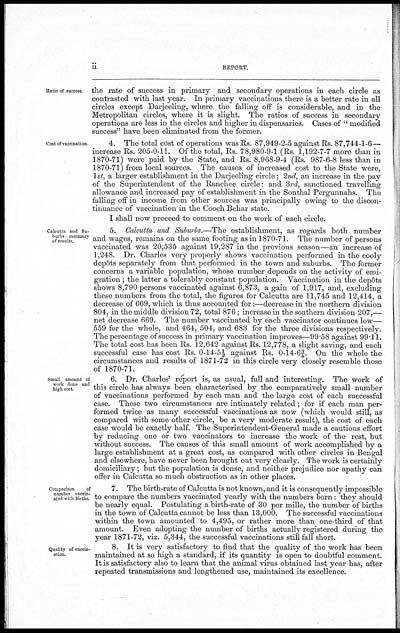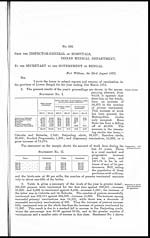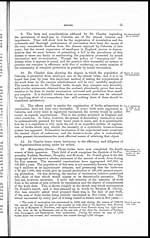Medicine - Vaccination > 1869-1873 - Report on vaccination in the Province of Bengal > Report on vaccination in the Province of Bengal for the year ending 31st March 1872
(218) Page ii
Download files
Individual page:
Thumbnail gallery: Grid view | List view

ii REPORT.
Ratio of success.
the rate of success in primary and secondary operations in each circle as
contrasted with last year. In primary vaccinations there is a better rate in all
circles except Darjeeling, where the falling off is considerable, and in the
Metropolitan circles, where it is slight. The ratios of success in secondary
operations are less in the circles and higher in dispensaries. Cases of " modified
success" have been eliminated from the former.
Cost of vaccination.
4. The total cost of operations was Rs. 87,949-2-5 against Rs. 87,744-1-6—
increase Rs. 205-0-11. Of the total, Rs. 78,980-9-1 (Rs. 1,192-7-7 more than in
1870-71) were paid by the State, and Rs. 8,968-9-4 (Rs. 987-6-8 less than in
1870-71) from local sources. The causes of increased cost to the State were,
1st, a larger establishment in the Darjeeling circle; 2nd, an increase in the pay
of the Superintendent of the Ranchee circle: and 3rd, sanctioned travelling
allowance and increased pay of establishment in the Sonthal Pergunnahs. The
falling off in income from other sources was principally owing to the discon-
tinuance of vaccination in the Cooch Behar state.
I shall now proceed to comment on the work of each circle.
Calcutta and Su-
burbs: summary
of results.
5. Calcutta and Suburbs.—The establishment, as regards both number
and wages, remains on the same footing as in 1870-71. The number of persons
vaccinated was 20,535 against 19,287 in the previous season—an increase of
1,248. Dr. Charles very properly shows vaccination performed in the cooly
depôts separately from that performed in the town and suburbs. The former
concerns a variable population, whose number depends on the activity of emi-
gration ; the latter a tolerably constant population. Vaccination in the depôts
shows 8,790 persons vaccinated against 6,873, a gain of 1,917, and, excluding
these numbers from the total, the figures for Calcutta are 11,745 and 12,414, a
decrease of 669, which is thus accounted for:—decrease in the northern division
804, in the middle division 72, total 876; increase in the southern division 207,—
net decrease 669. The number vaccinated by each vaccinator continues low—
559 for the whole, and 464, 504, and 683 for the three divisions respectively.
The percentage of success in primary vaccination improves—99.58 against 99.11.
The total cost has been Rs. 12,642 against Rs. 12,778, a slight saving, and each
successful case has cost Rs. 0-14-5½ against Rs. 0-14-6¾. On the whole the
circumstances and results of 1871-72 in this circle very closely resemble those
of 1870-71.
Small amount of
work done and
high cost.
6. Dr. Charles' report is, as usual, full and interesting. The work of
this circle has always been characterised by the comparatively small number
of vaccinations performed by each man and the large cost of each successful
case. These two circumstances are intimately related; for if each man per-
formed twice as many successful vaccinations as now (which would still, as
compared with some other circle, be a very moderate result), the cost of each
case would be exactly half. The Superintendent-General made a cautious effort
by reducing one or two vaccinators to increase the work of the rest, but
without success. The causes of this small amount of work accomplished by a
large establishment at a great cost, as compared with other circles in Bengal
and elsewhere, have never been brought out very clearly. The work is certainly
domiciliary; but the population is dense, and neither prejudice nor apathy can
offer in Calcutta so much obstruction as in other places.
Comparison of
number vaccin-
ated with births.
7. The birth-rate of Calcutta is not known, and it is consequently impossible
to compare the numbers vaccinated yearly with the numbers born: they should
be nearly equal. Postulating a birth-rate of 30 per. mille, the number of births
in the town of Calcutta cannot be less than 13,000. The successful vaccinations
within the town amounted to 4,495, or rather more than one-third of that
amount. Even adopting the number of births actually registered during the
year 1871-72, viz. 5,344, the successful vaccinations still fall short.
Quality of vaccin-
ation.
8. It is very satisfactory to find that the quality of the work has been
maintained at so high a standard, if its quantity is open to doubtful comment.
It is satisfactory also to learn that the animal virus obtained last year has, after
repeated transmissions and lengthened use, maintained its excellence.
Set display mode to: Large image | Zoom image | Transcription
Images and transcriptions on this page, including medium image downloads, may be used under the Creative Commons Attribution 4.0 International Licence unless otherwise stated. ![]()
| India Papers > Medicine - Vaccination > Report on vaccination in the Province of Bengal > Report on vaccination in the Province of Bengal for the year ending 31st March 1872 > (218) Page ii |
|---|
| Permanent URL | https://digital.nls.uk/91535277 |
|---|
| Additional NLS resources: | |
|---|---|




